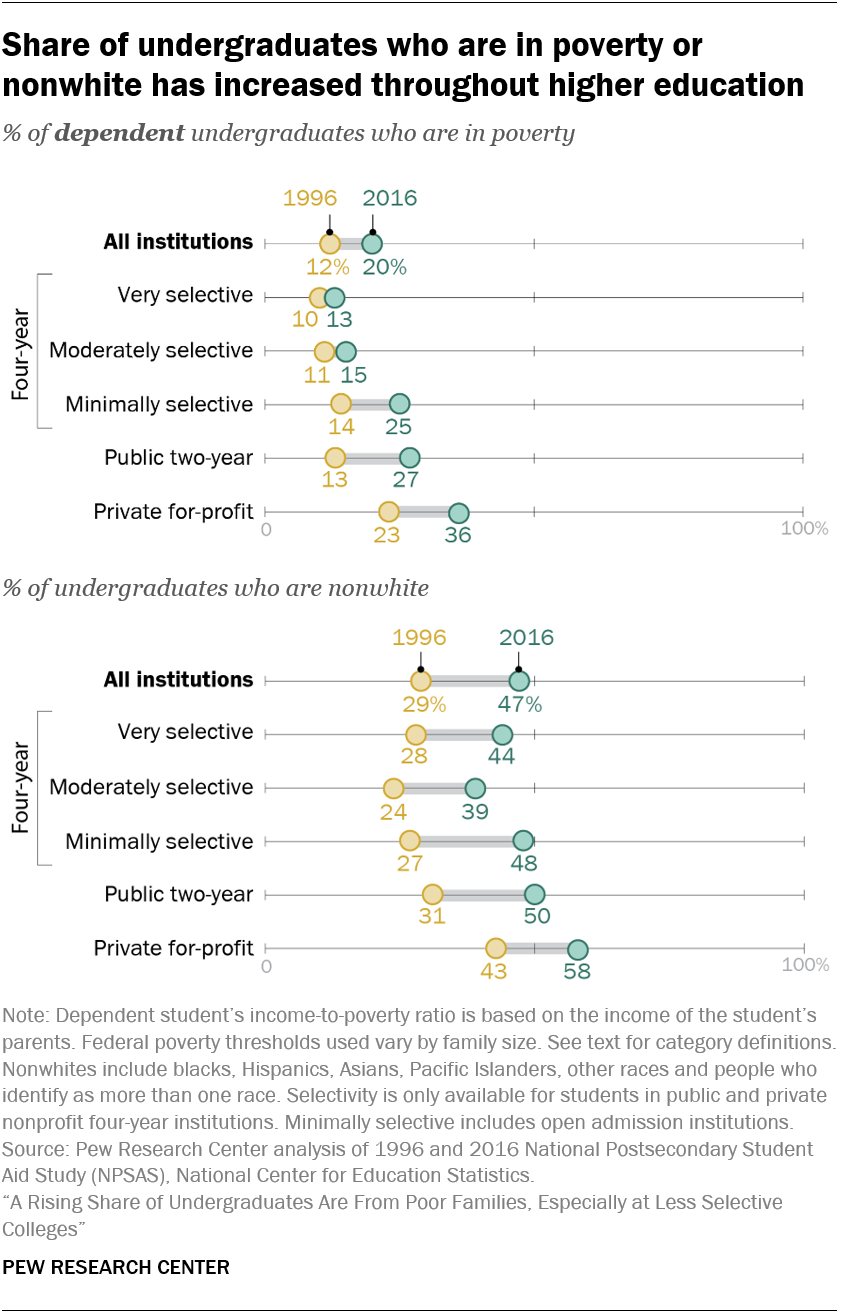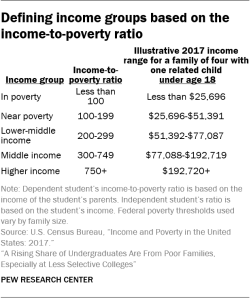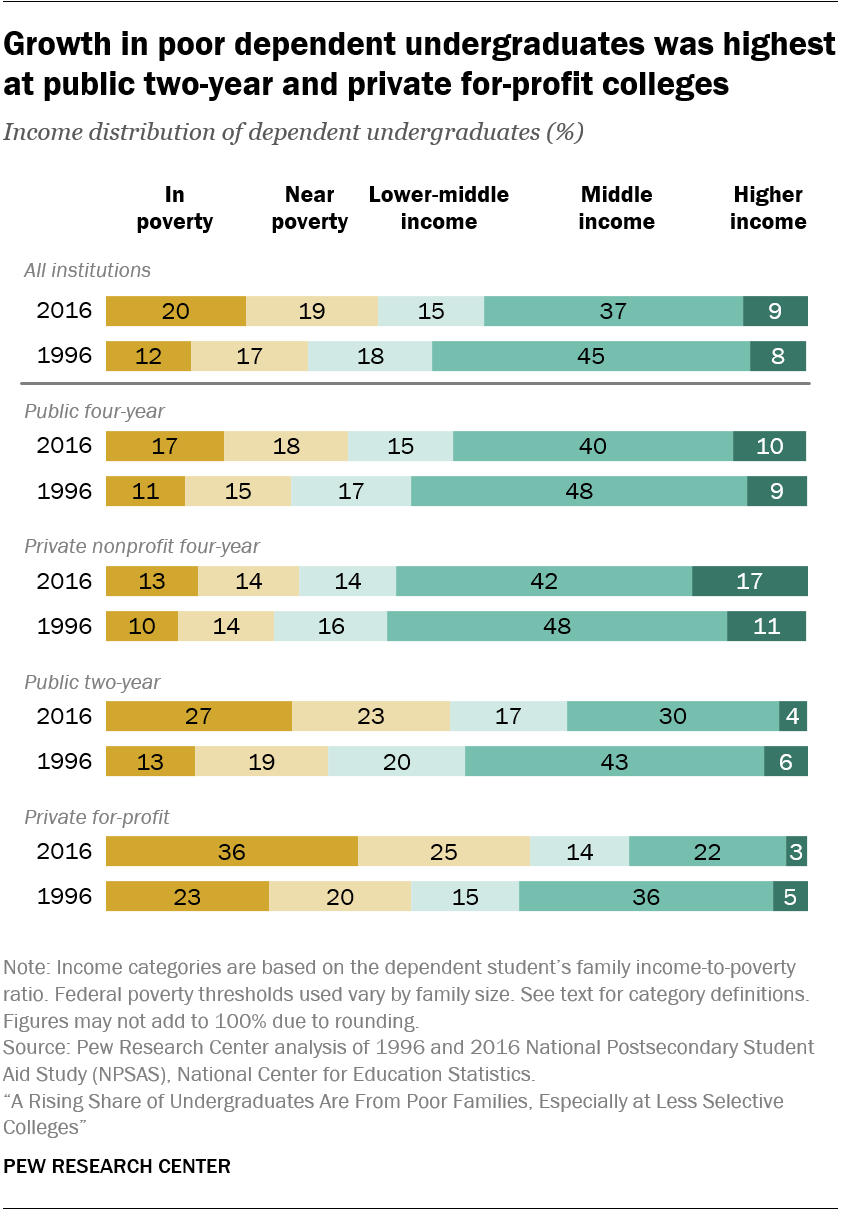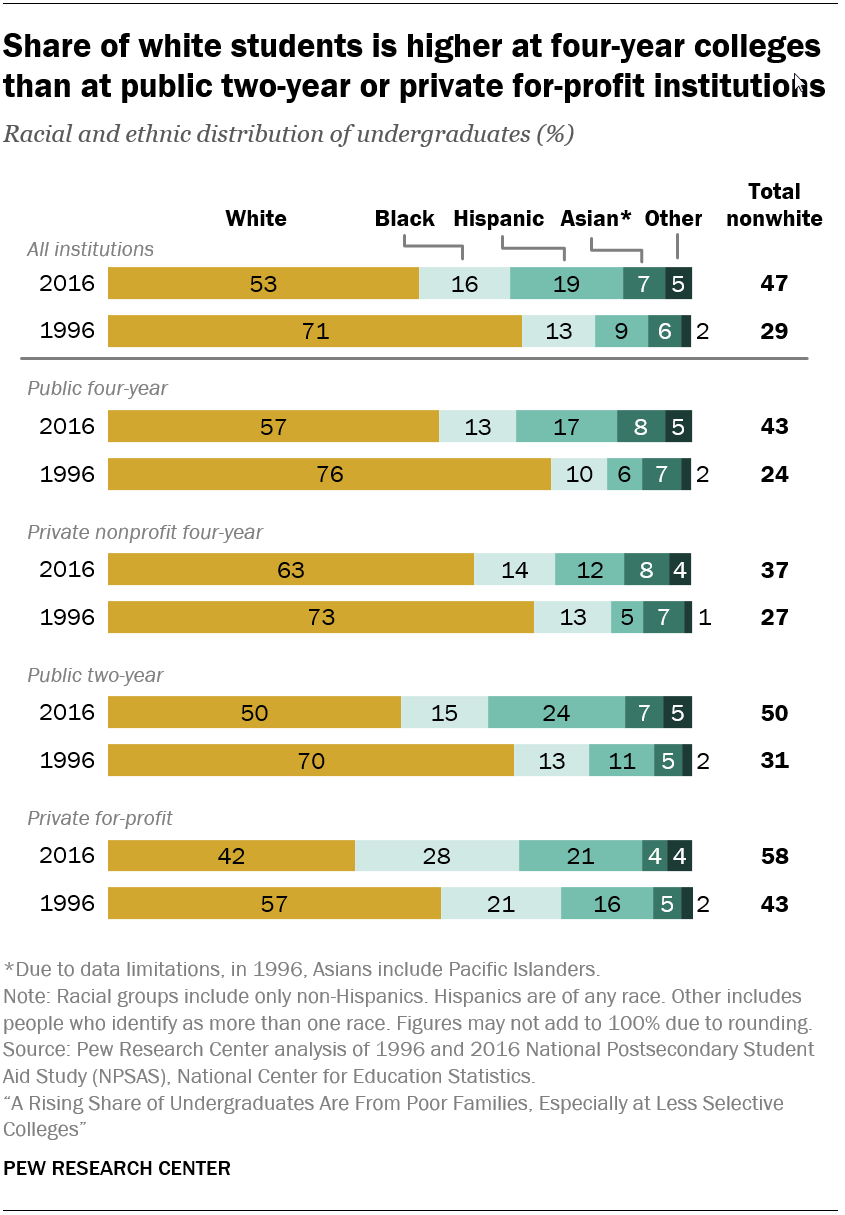


The overall number of undergraduates at U.S. colleges and universities has increased dramatically over the past 20 years, with growth fueled almost exclusively by an influx of students from low-income families and students of color. But these changes are not occurring uniformly across the postsecondary landscape. The rise of poor and minority undergraduates has been most pronounced in public two-year colleges and the least selective four-year colleges and universities, according to a new Pew Research Center analysis of National Center for Education Statistics data. There has been less change at the nation’s more selective four-year colleges and universities, where a majority of dependent undergraduates continue to be from middle- and higher-income families.

The economic background of students is based on the family income-to-poverty ratio, a common measure that has the advantage of accounting for family size. For a given income, larger families are less well-off.
The economic situation of dependent students is based on their parents’ financial resources. For independent students, only the students’ own income (as well as any spousal income) is considered. In most instances the student’s income is derived from the student’s financial aid application and not from the student’s self-report. The nation’s undergraduates are about evenly divided between dependent and independent students, a proportion that has not changed much.
Students fall into one of five income categories ranging from “in poverty” at the low end to “higher income” at the top. As an illustration, based on recent poverty levels a student from a family of four is in poverty if the family income is below $25,696, and if the income is $192,720 or higher (an income-to-poverty ratio of at least 750) then the student is “higher income.”
As of the 2015-16 academic year (the most recent data available), about 20 million students were enrolled in undergraduate education, up from 16.7 million in 1995-96.1 Of those enrolled in 2015-16, 47% were nonwhite and 31% were in poverty, up from 29% and 21%, respectively, 20 years earlier.2
The rising proportion of undergraduates in poverty does not mirror wider trends in society. The official poverty rate for adults age 18 to 64 (12%) was similar in 1996 and 2016, suggesting that access to college for students from lower-income backgrounds has increased since 1996.


The share of students in poverty differs considerably between dependent students – those who are younger than 24 and assumed to be receiving financial support from their family – and independent students, which includes those ages 24 and older as well as younger students assumed to be receiving little or no financial support from their parents. In 2016, 20% of dependent students were in poverty, up from 12% in 1996. Among independent students, fully 42% were in poverty in 2016, compared with 29% 20 years earlier.
The increase in the share of dependent students who are in poverty has been most pronounced at private for-profit colleges, public two-year institutions, and minimally selective and open admission four-year colleges and universities. At more selective institutions, a growing share of dependent undergraduates are from higher-income families (incomes at least 7.5 times the poverty line). For poor independent students, the increase has been substantial across different types of postsecondary institutions.
The share of undergraduates who are racial or ethnic minorities has increased in all types of postsecondary institutions, reflecting at least in part the country’s changing demographics. But the change has been most pronounced in public two-year and minimally selective four-year colleges.
The increase in the minority share of undergraduates comes amid a relatively large increase in Hispanic enrollment. Hispanic undergraduates have more than doubled their share of enrollment at four-year colleges and universities since 1996 (from 6% to 16% in 2016). Hispanics are now the largest minority group among students at minimally selective four-year institutions (eclipsing the black share of enrollment) and are even with the black share of enrollment at moderately selective four-year institutions.
The analysis also finds that undergraduates today are more likely to borrow to pay for college expenses, with the greatest increase among middle- and higher-income students. In 2016, 39% of middle-income students took out a loan, similar to the borrowing rate of students in poverty (38%). The likelihood of borrowing is now mostly unrelated to income, marking a significant change from the past. Undergraduates are also significantly less likely to be employed while enrolled than in 1996.
Larger shares now attend four-year and private for-profit institutions, with fewer at community colleges

Compared with 20 years ago, undergraduates are now less likely to be enrolled in community colleges. Public two-year institutions educated 36% of undergraduates in 2016, down from 44% in 1996.3 Enrollment increased at public four-year colleges and universities and private for-profit institutions. In 2016, 32% of undergraduates were enrolled in public four-year institutions, compared with 30% in 1996. The share enrolled in private for-profit institutions steeply increased from 1996 (5%) to 2012 (13%) but has contracted recently (9%).
While the share of undergraduates at four-year colleges and universities has increased overall, the share of four-year undergraduates educated by very selective institutions has fallen since 1996. The share enrolled at minimally selective and open admission institutions has increased over that time.
The type of institution a student attends is important because more-selective institutions are associated with better student outcomes. For example, about four-in-ten undergraduates beginning at public two-year colleges (39%) have finished an undergraduate credential (either a certificate, associate’s degree or bachelor’s degree) within six years. The corresponding completion rate for undergraduates beginning at a four-year institution is significantly higher (67%).
More-selective institutions devote more resources to a student’s education in terms of instructional spending and faculty qualifications. In addition, students graduate at higher rates at more selective institutions, and earnings after college may be higher for students from selective institutions.
Undergraduates increasingly likely to be from families in poverty
In 2016, 20% of dependent undergraduates were from families in poverty, a sharp rise from 1996 (12%). Since poverty in the wider 18- to 64-year-old population remained flat at about 12% during these same periods, it suggests that more poor students are participating in postsecondary education than 20 years earlier.
The share of dependent undergraduates who are from higher-income families has remained at roughly one-in-ten students from 1996 to 2016.
As the ranks of poor and near-poor students have grown and the share of higher-income students has held steady, the share of dependent undergraduates from lower-middle-income and middle-income families has decreased from 1996 (63%) to 2016 (52%).
Independent undergraduates are about twice as likely as dependent students to be in poverty (42% vs. 20%). As is the case among dependent students, the share of independent students in poverty has risen considerably since 1996, while the share who are lower-middle and middle income has fallen and the share who are higher income has remained stable at 3%.
Share of undergraduates in poverty has grown most at less selective institutions

The growth in the share of dependent students from families in poverty has been uneven across postsecondary education. Their growing presence has been most dramatic among less selective institutions. At community colleges, the share of dependent students who are in poverty has doubled from 13% in 1996 to 27% in 2016. Similarly, private for-profit institutions have experienced a 13 percentage point increase in the share of dependent students who come from poor families. In turn, public and private nonprofit four-year schools have had more modest growth in students from families in poverty (6 and 3 percentage points, respectively) since 1996.
The shares of dependent students from higher-income families have remained relatively stable at public two-year and four-year colleges and at private for-profit institutions since 1996. But a larger share of dependent students at private nonprofit four-year schools now comes from higher-income families (17% in 2016 vs. 11% in 1996).

A similar pattern emerges when looking at the share of students in each income group at four-year colleges and universities by admissions selectivity.4 At minimally selective and open admission institutions, poor students have nearly doubled their presence from 14% in 1996 to 25% in 2016. The growth in the share of poor students at moderately selective and very selective four-year institutions has been more modest. At more selective four-year colleges and universities, a growing share of dependent students come from higher-income families. For example, at moderately selective four-year institutions, 12% of dependent students were from a higher-income background in 2016, up from 7% in 1996.
A different pattern appears in the changing income background of independent undergraduates. Among independent undergraduates, the changes are not aligned with selectivity. For example, the shares of independent students with higher incomes are small and unchanged among all types of institutions. Meanwhile, rising shares of independent students are in poverty, and the largest increase occurred at very selective four-year institutions: 52% of these students were in poverty in 2016, up from 32% in 1996 (see figures in Appendix).
Share of nonwhite undergraduates has increased at all types of postsecondary institutions

Reflecting broader changes in the U.S. population, racial and ethnic minorities are increasing as a share of undergraduates at public and private nonprofit four-year colleges and universities. The same is true at public two-year and private for-profit institutions, although whites remain the majority at four-year institutions.
The growth in the minority share of undergraduates has been greater in the less selective tiers of postsecondary education. The share of nonwhite undergraduates at community colleges and public four-year colleges and universities each increased by 19 percentage points from 1996 to 2016, but only 10 points at private nonprofit four-year institutions (from 27% to 37%).
Among undergraduates enrolled at public and private nonprofit four-year institutions, the presence of minority students has increased most at minimally selective and open admission institutions (21 percentage points). The minority share of enrollees has grown less at very selective and moderately selective four-year institutions (by 16 and 15 points, respectively).

The increase in minority enrollees is partly driven by Hispanic enrollment growth. The growth of Hispanic undergraduates reflects both demographic trends and increasing educational attainment. As of the 2000 census, Hispanics became the second-largest racial and ethnic group in the overall population, behind non-Hispanic whites. It took longer for Hispanics to reach similar milestones in educational attainment. Hispanics outnumbered blacks among the nation’s public high school graduates starting in the 2007-08 academic year. The share of Hispanic youth enrolling in college has markedly increased in this century.
Hispanic undergraduate growth has been greatest at less selective tiers. The Hispanic share of public two-year enrollees has increased from 11% in 1996 to 24% in 2016 – a 12 percentage point increase.5 Their presence at private non-profit four-year institutions increased a more modest 6 points (from 5% in 1996 to 12% in 2016).
Among four-year enrollees, Hispanics increased their share at minimally selective and open admission four-year institutions by 15 percentage points (from 6% in 1996 to 22% in 2016). At moderately selective and very selective four-year colleges and universities, Hispanics increased their enrollment share by 8 percentage points. But Hispanic growth among moderately selective four-year institutions has been enough that they now equal the black share of enrollment at these institutions.
Students in poverty are no more likely to take out a student loan than other undergraduates

A rising share of undergraduates are borrowing to pay for college. Some 39% of undergraduates took out a loan during the 2016 academic year, compared with 26% in 1996.6
The pattern of borrowing by students has radically shifted since 1996. In 1996, students that were in poverty were the most likely to borrow (33%) and higher-income students were the least likely to do so (8%). In 2016, there was no longer a clear relationship between the likelihood of borrowing and student income: 38% of students in poverty took out loans, as did 30% of higher-income students. Middle-income undergraduates were just as likely to borrow (39%) as those who were in poverty (38%).
Students attending four-year colleges and universities are more likely to borrow than community college students. But, with the exception of students in the private for-profits, the share of students borrowing has increased by about 10 percentage points at both two-year and four-year institutions.
The analysis also finds that undergraduates increasingly are not working while enrolled. In 2016, 36% of undergraduates were not employed, compared with 20% in 2000 (comparable work information is not available for 1996). The share working full time dropped significantly, from 38% in 2000 to 25% in 2016.
An undergraduate refers to a student enrolled in a postsecondary institution (private for-profit as well as public and private nonprofit institutions) and includes those pursuing a certificate or associate’s degree as well as those pursuing a bachelor’s degree.
“Dependent students” refers to undergraduates ages 23 and younger who are not married and do not have dependent children. Independent students include those who are older than 23 as well as those ages 23 and younger who are married or have dependent children.
Public two-year institutions are also known as community colleges. Private for-profit institutions refer to the roughly 3,400 colleges and universities that operate as businesses. Their program offerings often emphasize career preparation and have few or no general education requirements.
Public and private nonprofit four-year colleges and universities are classified as very selective, moderately selective, and minimally selective and open admission using the National Center for Education Statistics classification. This is based in part on ACT and/or SAT scores and how many students were accepted among those who applied.
In 2016, references to whites, blacks and Asians include only those who are non-Hispanic and identify as only one race. In 1996, Asians included Pacific Islanders and the Hispanic portion of this group. Hispanics are of any race. Nonwhites include blacks, Hispanics, Asians, Pacific Islanders, other races and people who identify as more than one race.




